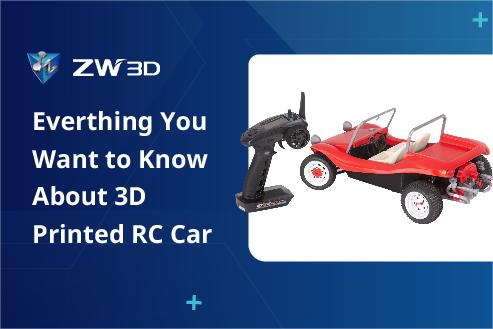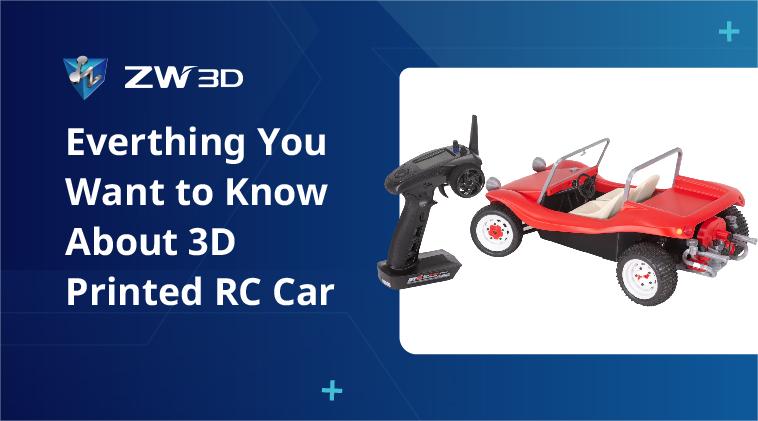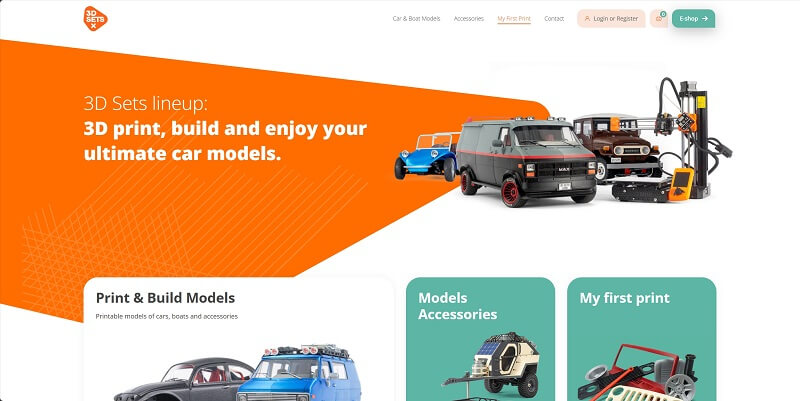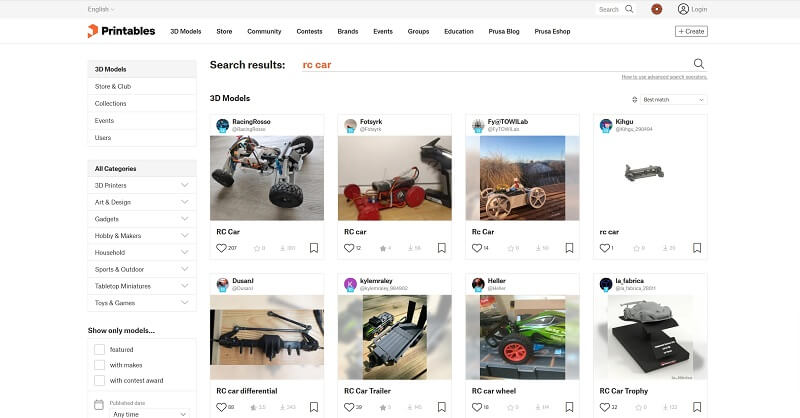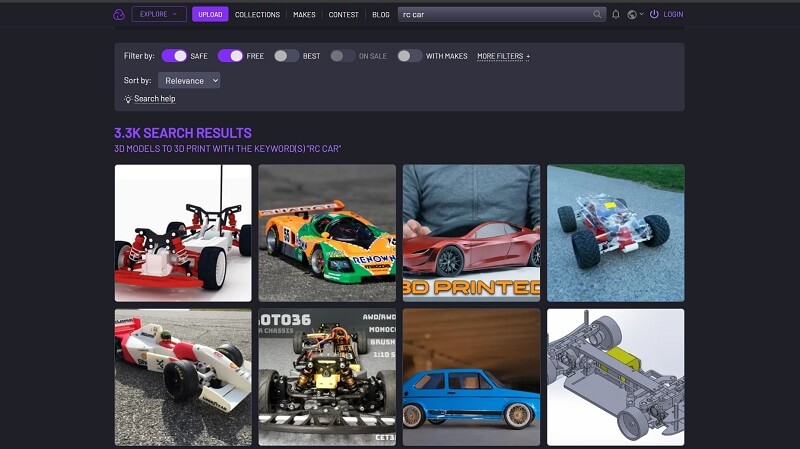Want to drive an RC car like an F1 racer? RC cars on the market range in price from a dozen to several thousand dollars, but it is not easy to find a model that meets all your needs, especially some uncommon or modified models. Fortunately, 3D printing technology has brought the RC car community new possibilities, making it one of the most popular things to make on a 3D printer today.
Do you also want to customize and 3D print RC cars to enrich your collection? This article will take you to explore the world of 3D-printed RC cars and provide practical tips to help you better find and download RC car STL files for 3D printing. Let’s get started!
| Note: ZWSOFT recently released ZW3D 2025, top-notch 3D modeling software that’s perfect whether you’re considering a switch or are a beginner looking for a great option. This all-in-one 3D CAD/CAE/CAM solution boasts powerful 3D modeling capabilities and offers a one-time purchase option, making it much more cost-effective in the long run compared to other software. If you’re interested, you can download a trial version. |
What Is 3D Printed RC Car?
A 3D-printed RC car is a customizable vehicle model made using 3D printing technology. Its main parts, such as the body, chassis, wheels, and some connectors, are usually printed out using a 3D printer based on model designs. Other parts, such as motors, batteries, control circuits, and remote controllers, are usually purchased from the store directly. Popular 3D-printed RC cars today include racing cars, trucks, tanks, etc.
The entire manufacturing process usually starts with designing a 3D model of the RC car using 3D modeling software or downloading printable STL files online. Then, import the 3D model into a 3D printer and select appropriate printing filaments to 3D print each part. These filaments will be stacked up layer by layer to create the physical parts. After printing, assemble all the 3D-printed RC car parts with the purchased electronics to create the complete RC car.
Unlike traditional RC cars that are pre-made and lack flexibility, the biggest feature of 3D-printed RC cars is their high degree of customization and personalization, which allows users to fully explore their imagination and create models with complex details. Additionally, the initial cost of 3D-printed RC cars is relatively lower because there’s no need for expensive molds, and parts can be printed relatively quickly. Although mass production is not yet possible, this production method is especially ideal for creating unique, personalized 3D-printed RC cars.
Where Can You Download RC Car 3D Print Files?
If you want to create a one-of-a-kind RC car, using 3D modeling software offers a viable solution. However, it can be time-consuming, especially for those who are unfamiliar with the software. Thanks to 3D printing technology, directly downloading ready-made STL files online delivers a quick and easy option to 3D print RC cars. Here, we introduce you to several popular platforms where you can find these files.
1. 3D Sets
If you’ve never tried 3D printing an RC car, consider getting started with 3D Sets. This website offers a large selection of printable STL files for RC car models and parts, which you can easily download and print to build your own RC cars. These files are designed by experienced 3D designers to ensure both the performance and good looks of your RC car.
Even better, they are customizable, enabling you to customize the 3D-printed RC car body by choosing colors, adding accessories, and more, based on your preference. If you are looking for high-quality 3D-printed RC cars, 3D Sets is definitely a good choice.
In addition, this platform also provides helpful information for 3D printing RC cars, including recommended filaments, suggested settings, and even step-by-step printing instructions with tips, etc. This can greatly help you get started and create amazing 3D-printed RC cars by yourself. Meanwhile, it should be noted that high-quality services also mean that the cost of these 3D-printed RC cars can be relatively higher than other options.
Free or Paid: Paid
2. Printables
Printables is another platform for printable STL files for 3D RC car printing. Unlike 3D Sets, most of the RC car files on Printables are shared by 3D printing enthusiasts for free. If you are on a budget, this is a great place to start.
Just type in “3D-printed RC car body” or “3D-printed RC car parts”, and then you can effortlessly explore all the printable and downloadable STL files for your RC car. Thankfully, these files are accessible, so you can customize and build a unique 3D-printed RC car design to your liking.
Meanwhile, Printables boasts an active community, where users can share their 3D projects, ask for help, or whatever. This facilitates you to communicate with other 3D printing enthusiasts. However, the quality of models on Printables varies from low to high detail. Therefore, a careful selection is required if you want a high-quality 3D-printed RC car.
Free or Paid: Free
3. Thingiverse
Thingiverse is one of the largest online sources for 3D models, offering a variety of RC car models, such as racing cars, off-road vehicles, SMARS, and more. Whether you are looking for a classic model or the fastest 3D-printed RC car, Thingiverse has you covered.
Moreover, it provides extensive customizable options, enabling you to freely download, modify, and personalize the appearance and features of the chosen model to build a truly unique RC car. Additionally, for your 3D printing convenience, designers on Thingiverse usually provide multiple file formats such as STL, STEP, OBJ, and 3MF to ensure compatibility with your 3D printer.
If you are completely new to 3D printing RC cars, Thingiverse is a great option. Not only does it deliver a huge library of downloadable and printable 3D printing files, but most of the files are free, which can be a great help to your tight budget. Plus, it also has an active community that offers a great platform for you to share your prints, get help and advice, and interact with like-minded friends.
Free or Paid: Free
4. Cults
When you are looking for the best platform to download STL files for 3D printing RC cars, you can’t miss Cults. Cults, a popular 3D modeling source, offers various 3D-printed RC car models, including both free and paid options. To make it easy for you to quickly find the right printable files, this platform offers a powerful filter that allows you to pinpoint the models that meet your requirements by options such as file formats, licenses, categories, tags, etc. Also, you can even sort by Downloads or Likes to see the most popular models easily.
Although Cults has a relatively small library compared to other platforms, it does offer some unique 3D-printed RC cars that may not be found on other options. Moreover, the models on Cults are usually well-designed and crafted with good details, delivering high quality.
Free or Paid: Free & Paid
Materials and Equipment for 3D RC Car Printing
Common materials used to produce 3D-printed RC car parts include TPU, PLA, ABS, PETG, PC, etc. However, the materials used for each part may vary due to different requirements. See below for a detailed introduction.
- Body, Shell Components, Protection Cover, and Guard Plate – PLA is ideal for these parts as it is best looking and easy to print with a smooth surface. However, be careful of potential deformation issues when using large FMD printers.
- Chassis, Suspension System, and Motor Bracket – For durable chassis and suspension systems requiring high strength and heat resistance, PETG, Nylon, or PC are recommended. For motor brackets, ABS and PETG are more suitable. Considering the potential wear, it is advisable to strengthen the structural strength, increase the wall thickness, or reinforce the key parts during design. Also, FDM printers are still the preferred choice for printing these parts.
- Tires and Wheel Components – These elastic parts require flexibility and abrasion resistance, making TPU the ideal choice due to its excellent grip and durability. When selecting a 3D printer, ensure it is compatible with TPU to avoid potential compatibility issues.
- Suspension System Shock Absorbers – PC offers suspension system shock absorbers with excellent elasticity and durability against shocks and pressure. Thus, a 3D printer capable of high precision and handling elastic materials is preferred. Moreover, conducting repeated tests and adjustments during the design phase is crucial to ensure stable damping effectiveness.
- Transmission System Gears and Key Structural Components – To ensure the stability and long life of the parts, Nylon and PC are ideal choices. Also, smoothing the gears and using appropriate lubricants is necessary to ensure smooth operation. Additionally, for optimal 3D printing results, choosing a printer that can handle high precision and strength materials is crucial.
FAQs About 3D Printed RC Car
How Can I Improve the Surface Finish of My 3D Printed Parts?
After 3D printing an RC car, you may notice that the surface is rough and layered. To address this, you can try using sandpaper, a grinder, or chemical polish to smooth the surface. If these methods are not working, you can also consider adjusting the printing parameters. For example, you can try reducing the layer height, lowering the printing temperature, and decreasing the printing speed to reduce vibration and irregular surfaces.
Additionally, optimizing the model design and appropriately increasing the fill and support structures can also help prevent surface roughness. If the previous methods still do not yield the desired results, it is advisable to switch to a 3D printer with higher precision to improve the surface quality of your 3D-printed RC car parts.
How to Reinforce Weak Points on My 3D Printed RC Car Chassis?
During use, the 3D-printed RC car chassis can experience impacts and stress from crashes, jumps, and rough terrain, potentially resulting in cracks or breaks. To strengthen the chassis, carefully check it to find out the weak points first.
The most straightforward way to avoid cracks and breaks is to increase the thickness of the material in these points to enhance strength. Also, adding support structures or beams around weak points and optimizing the structure to distribute stresses can be highly effective. Additionally, using materials such as ABS or PETG for 3D printing can also greatly improve the chassis’ impact and rupture resistance.
However, be cautious not to over-reinforce, as this can add unnecessary weight to the part and potentially affect performance. After reinforcing, make sure to test it and make timely adjustments and repairs according to the actual performance of your 3D-printed RC cars.
Conclusion
3D printing technology brings possibilities to RC car enthusiasts with greater freedom and customization. By going through this ultimate guide about 3D-printed RC cars with useful tips, you may already know where to find and download STL files for 3D printing online, what materials are required, how to refine your car, etc. Are you ready to build your own one? Let’s start your journey of 3D printing RC cars!
Was this article helpful? If it was, please share it with others who may benefit from it!
.png)
